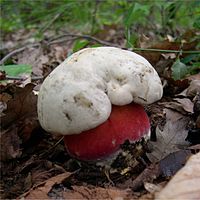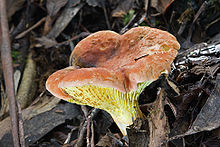- Boletaceae
-
Boletaceae 
Cep, Boletus edulis Scientific classification Kingdom: Fungi Division: Basidiomycota Class: Agaricomycetes Order: Boletales Family: Boletaceae
Chevall. (1828)Type genus Boletus
Fr. (1821)Synonyms Boletellaceae Jülich (1981)
Chamonixiaceae Jülich (1981)
Octavianiaceae Locq. ex Pegler & T.W.K.YoungBoletaceae are a family of mushrooms, primarily characterized by developing their spores in small pores on the underside of the mushroom, instead of gills, as are found in agarics. Nearly as widely distributed as agarics, they include the Cep or King Bolete (Boletus edulis), much sought after by mushroom hunters. As a whole, the typical members of the family are commonly known as boletes.
Boletes are a relatively safe group of mushrooms for human consumption, as none are known to be deadly to adults, and they are the most sought after fungi for mushroom hunting. They are especially suitable for novice mushroom hunters, since there is little danger of confusing them with deadly mushrooms, like various Amanita agarics, which are the most poisonous mushrooms in the world. They are easily distinguished from agarics, and easily recognized for colour, pores and thick stems and caps.
Contents
Description
Most species in Boletaceae produce large fleshy mushrooms with a central stipe. The spore print colours are commonly olivaceous (yellowish-green), yellowish, brownish, or vinaceous (red-wine coloured). In many species, flesh that is bruised or cut will turn blue, a result of the oxidation of pulvinic acid derivatives, like variegatic, xerocomic, and atrotomentinic acid.[1] The mushrooms usually have tubular hymenophores, although some species (like those in the genus Phylloporus) are lamellate.
Taxonomy
Boletaceae were first described by the French botanist François Fulgis Chevallier in 1826 as a family distinct from Agaricaceae. Five genera were included in Chevallier's circumscription: Boletus, Cladosporus (now synonymous with Laetiporus[2]), Physisporus (now Perenniporia[3]), Polyporus, and Fistulina.[4]
Genera
Devil's bolete (Boletus satanas)
Rolf Singer, in the 4th edition (1986) of his Agaricales in Modern Taxonomy, included 26 genera and 415 species in the Boletaceae.[5] Molecular phylogenetic studies of the 2000s have revised our concept of the family; in a highly-cited 2006 publication, Manfred Binder and David Hibbett included 38 genera.[6] Even after recent changes in classification that have moved many members out of the Boletaceae, it remains a large family with many genera. According to the Dictionary of the Fungi (10th edition, 2008), 35 genera are recognized in Boletaceae, which collectively contain 787 species.[7]
Genus Authority Year # of species Distribution Afroboletus Pegler & T.W.K.Young 1981 7 tropical Africa Aureoboletus Pouzar 1957 5 widespread Austroboletus Wolfe 1980 ~30 America; Australia Boletellus Murrill 1909 ~50 widespread Boletochaete Singer 1944 3 Africa; Southeast Asia Boletus Fr. 1821 ~300 widespread Bothia Halling, T.J.Baroni, & Binder 2007 1 North America Buchwaldoboletus Pilát 1962 3 Europe; Australia Chalciporus Bataille 1908 25 widespread Chamonixia Rolland 1899 8 widespread Fistulinella Henn. 1901 15 pantropical Gastroboletus Lohwag 1962 13 widespread Gastroleccinum Thiers 1989 1 North America Heimioporus E.Horak 2004 ~15 widespread Heliogaster[8] (Kobayasi) Orihara & Iwase 2010 1 Japan Leccinellum Bresinsky & Manfr. Binder 2003 10 widespread Leccinum Gray 1821 ~75 widespread Mycoamaranthus Castellano, Trappe & Malajczuk 1992 3 Australasia; Africa, Southeast Asia Octaviania Vittad. 1831 15 widespread Paxillogaster E.Horak 1966 1 South America Phylloboletellus Singer 1952 1 Central and South America Phyllobolites Singer 1942 1 South America Phylloporus Quel. 1888 ~50 cosmopolitan Pseudoboletus Šutara 1991 2 north temperate regions Pulveroboletus Murrill 1909 25 cosmopolitan Retiboletus Manfr. Binder & Bresinksy 2002 5 north temperate regions Rhodactina Pegler & T.W.K.Young 1989 1 India Royoungia Castellano, Trappe & Malajczuk 1992 1 Australia Setogyroporus Heinem. & Rammeloo 1999 1 tropical Africa Singeromyces M.M.Moser 1966 1 Argentina Sinoboletus M.Zang 1992 10 China Spongiforma[9] Desjardin, Manf. Binder, Roekring & Flegel 2009 2 Thailand Strobilomyces Berk. 1851 ~20 cosmopolitan Tubosaeta E.Horak 1967 5 Africa; Asia Tylopilus P.Karst 1881 ~75 widespread Veloporphyrellus L.D.Gómez & Singer 1984 1 Central America Wakefieldia Corner & Hawker 1952 2 Asia; Europe Xanthoconium Singer 1944 7 cosmopolitan Zangia[10] Yan C.Li & Zhu L.Yang 2011 6 China Many other genera formerly part of this family have been moved into other, smaller families as work with molecular phylogeny shows that they are more distantly related, even if physically similar. Representative of this adjustment is the move of the slimy-capped genus Suillus to Suillaceae.
Distribution
Boletes are found worldwide, on every continent except Antarctica. Well-known and well-described in the temperate latitudes in the northern hemisphere, newer research has shown significant diversity in tropical and southern hemisphere regions as well. E. J. H. Corner found evidence of at least 60 species on the island of Singapore alone. In 1972 he described 140 species from the Malay Peninsula and Borneo and estimated there were an equal number again to be found.[11]
Similar statements about the biodiverse richness of Australian Boletaceae have also been made.[citation needed]
Edibility
Many of the boletes are considered to be true culinary delicacies, especially the king bolete (Boletus edulis); the Scandinavian cuisine praises boletes. In Finnish cuisine, the king bolete is universally considered to be the tastiest culinary mushroom. A large number of boletes are delicious or at least edible. Poisonous or otherwise inedible species do exist, however, such as the unpalatable bitter species Boletus calopus and the aptly named bitter bolete (Tylopilus felleus) with a taste compared to gall bladder juice, and some orange-capped species of Leccinum. As the bitter bolete resembles somewhat the king bolete, it can produce literally a bitter disappointment to the mushroom hunter! The rule of thumb is that bitter bolete has pink pores and brownish stem, while cep has whitish pale grey pores and stem. They also grow on different places and terrain. The peppery bolete (Chalciporus piperatus) has extremely strong taste, and has been used in place of pepper.[12]
Finnish cuisine uses boletes for various soups, sauces, casseroles and hotpots. They are sometimes also used as pizza filling, not unlike champignons, shiitake or portobellos.
Two of the best common edible boletes however are the bay bolete (Boletus badius), whose pores bruise blue-green, and the orange birch bolete, which is a Leccinum with an orange cap and which bruises a bluish grey.
Several guidebooks recommend avoiding all red-pored boletes, however both B. erythropus and B. luridus are edible when well-cooked. However, there has been one recorded instance of death from Boletus pulcherrimus in 1994; a couple developed gastrointestinal symptoms after eating this fungus with the husband succumbing. Autopsy revealed infarction of the midgut.[13] Boletus satanas has also long considered to be poisonous, though it has not been responsible for any deaths. The symptoms are predominantly gastrointestinal in nature. A glycoprotein, bolesatine, has been isolated. A similar compound bolevenine has been isolated from the poisonous Boletus venenatus of Japan.[14]
See also
- Bolete eater
References
- ^ Nelson SF. (2010). "Bluing components and other pigments of Boletes" (PDF). Fungi 3 (4): 11–14. http://www.fungimag.com/fall-2010-articles/BoletesLR.pdf.
- ^ Kirk et al., (2008), p. 146.
- ^ Kirk et al., (2008), p. 535.
- ^ Chevallier FF. (1826) (in French). Flore Générale des Environs de Paris. 1. p. 248.
- ^ Singer R. (1986). The Agaricales in Modern Taxonomy (4th ed.). Königstein im Taunus, Germany: Koeltz Scientific Books. ISBN 3-87429-254-1.
- ^ Binder M, Hibbett DS. (2006). "Molecular systematics and biological diversification of Boletales". Mycologia 98 (6): 971–81. doi:10.3852/mycologia.98.6.971. PMID 17486973.
- ^ Kirk et al. (2008), p. 96.
- ^ Orihara T, Sawada F, Ikeda S, Yamato M, Tanaka C, Shimomura N, Hashiya M, Iwase K. (2010). "Taxonomic reconsideration of a sequestrate fungus, Octaviania columellifera, with the proposal of a new genus, Heliogaster, and its phylogenetic relationships in the Boletales". Mycologia 102 (1): 108–21. doi:10.3852/08-168. PMID 20120234.
- ^ Desjardin DE, Binder M, Roekring S, Flegel T. (2009). "Spongiforma, a new genus of gasteroid boletes from Thailand". Fungal Diversity 37: 1–8.
- ^ Li YC, Feng B, Yang ZL. (2011). Fungal Diversity 49: 125–43. doi:10.1007/s13225-011-0096-y.
- ^ Corner EJH. (1972). Boletus in Malaysia. Government Printing Office/Botanic Gardens, Singapore. OCLC 668353.
- ^ Carluccio A. (2003). The Complete Mushroom Book. London, UK: Quadrille. ISBN 978-1-84400-040-1.
- ^ Benjamin DR. (1995). "Red-pored boletes". Mushrooms: poisons and panaceas—A Handbook for Naturalists, Mycologists and Physicians. New York, New York: WH Freeman and Company. pp. 359–60.
- ^ Matsuura M, Yamada M, Saikawa Y, Miyairi K, Okuno T, Konno K, Uenishi J, Hashimoto K, Nakata M. (2007). "Bolevenine, a toxic protein from the Japanese toadstool Boletus venenatus". Phytochemistry 68 (56): 893–98. doi:10.1016/j.phytochem.2006.11.037.
Cited texts
- Kirk PM, Cannon PF, Minter DW, Stalpers JA. (2008). Dictionary of the Fungi (10th ed.). Wallingford, UK: CABI. ISBN 9780851998268.
Categories:- Boletales
- Edible fungi
- Finnish cuisine
Wikimedia Foundation. 2010.


